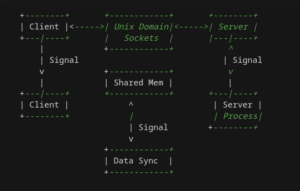Introduction 📜
When diving deep into the world of Linux and system programming, one can’t overlook the intricacies of how different processes talk to each other. This dance of communication and coordination is executed via a mechanism called inter-process communication (IPC). In this article, we shall explore an innovative approach that synchronizes data across processes utilizing the powers of Unix domain sockets and shared memory.
Project Architecture: A Bird’s Eye View 🕊🔍
Our project can be visualized as an intricate web where clients and servers exchange data in real-time. Here’s a simplified representation:

By taking a glance at the above architecture, you can observe the seamless data flow and robust synchronization mechanisms in place.
Highlight Features ✨🚀
1. Routing Table Manager (RTM) with Signal Handling 📡🚦
Dedicated Management: The heart of our system, RTM, adroitly handles the L3 routing table, ensuring that data knows where to go.
ARP Integration: Our system not only deals with routes but also efficiently manages ARP (Address Resolution Protocol) tables. This table helps in mapping IP addresses to physical addresses.
Notifications: If there’s a change, the system is on it. Real-time alerts are dispatched for any table modifications, ensuring every component stays updated.
Signal Handling: For those major announcements, like purging tables, we’ve embedded signal mechanisms to broadcast pivotal events.


2. Shared Memory in Client-Server Paradigm 🔄🔐
The RTM acts as the server, efficiently managing both routing and ARP tables. On the other side, client processes receive these real-time updates through Unix domain sockets and directly fetch the relevant data from shared memory.
3. Integrated CRUD Operations with Signal Mechanics 🛠🚦
Our system isn’t just about data storage; it’s about efficient data management. This means you can create, read, update, and delete records. And with every operation, the system can send real-time signal notifications.
4. Admin Dashboard: Precision Control 👩💼👨💼
This is where the magic happens. A dedicated interface for system admins provides granular control. Inserting MAC-IP pairs, modifying tables, or even flushing entire datasets is just a click away.
5. The Technical Grit: Data Structures and Memory Management 💾🔑🚦
Under the hood, several cogs and wheels make the system run smoothly:
Shared Memory Design: Leveraging MAC addresses as unique keys ensures streamlined access to IP addresses within shared memory.
Notification Blueprint: A specialized message construct is designed to relay operation codes and MAC address details seamlessly.
Signal Blueprint: We’ve incorporated the
SIGUSR1signal, which is utilized for significant notifications, like informing about a major table overhaul.
6. Flawless Client Termination Protocol 🛑✨
Ensuring a graceful exit is just as important. Clients, upon termination, clear their tables. Once done, they notify the server, which subsequently removes the client’s record, ensuring a tidy system environment.
Embark on the Journey 🚀
Dive deep into the codebase and contribute to the project’s growth! Check out our GitHub repository:
Epilogue
Venturing into the vast landscape of IPC within Linux might seem daunting. However, with tools and projects like this, we take a step closer to demystifying and optimizing these crucial communications. The amalgamation of Unix domain sockets and shared memory in this project is a testament to the future of efficient system programming.
Crafted with precision and passion by Anamika. Cheers to furthering the boundaries of technical innovation! 🌟🍻
